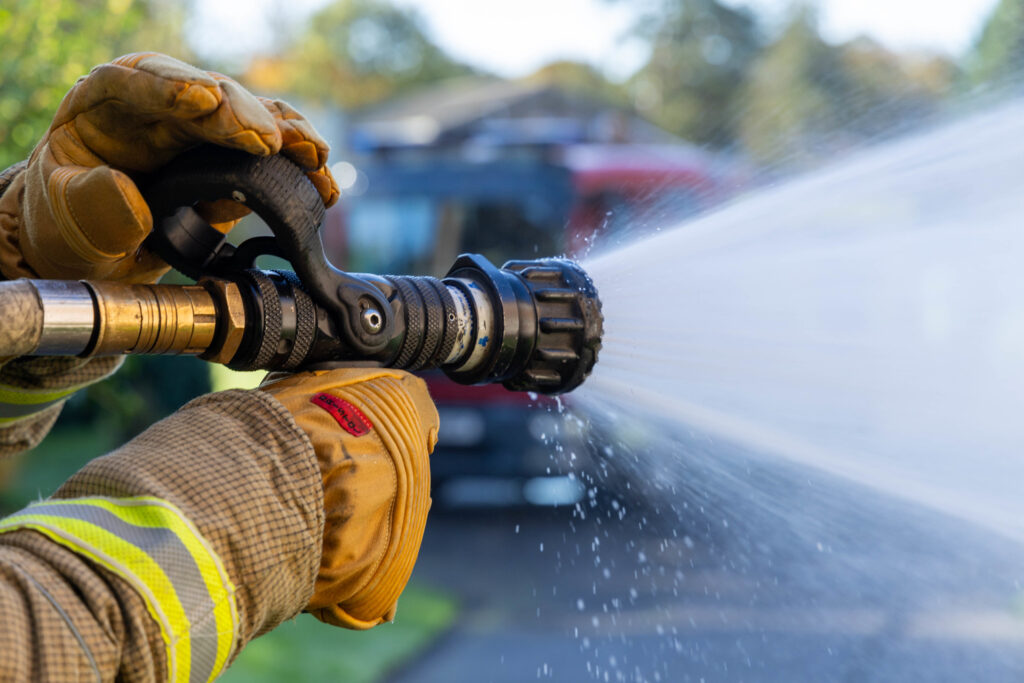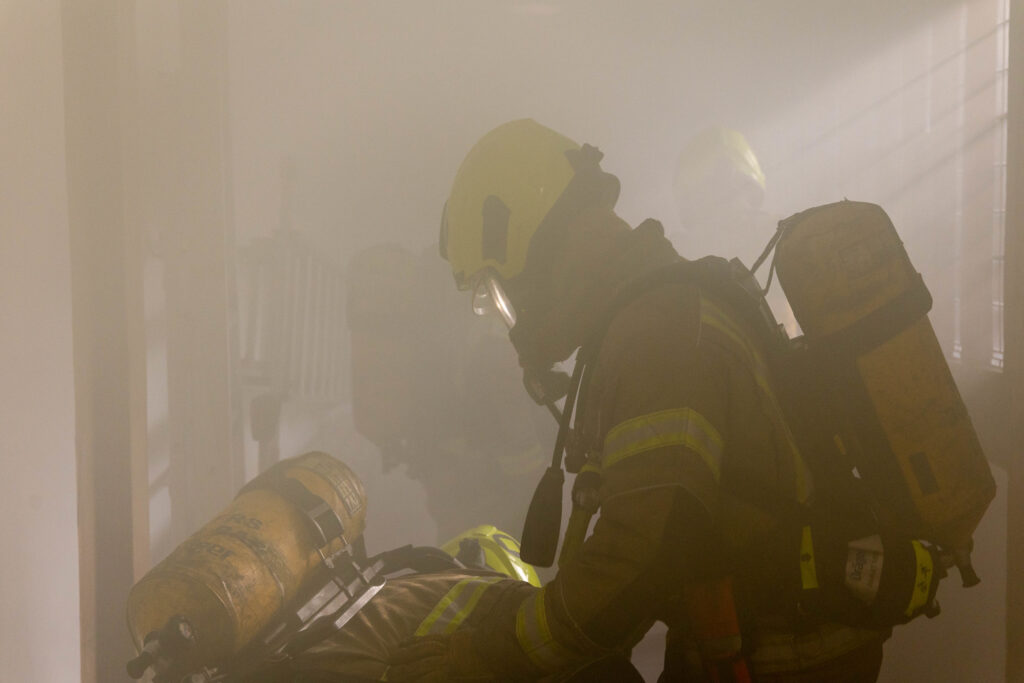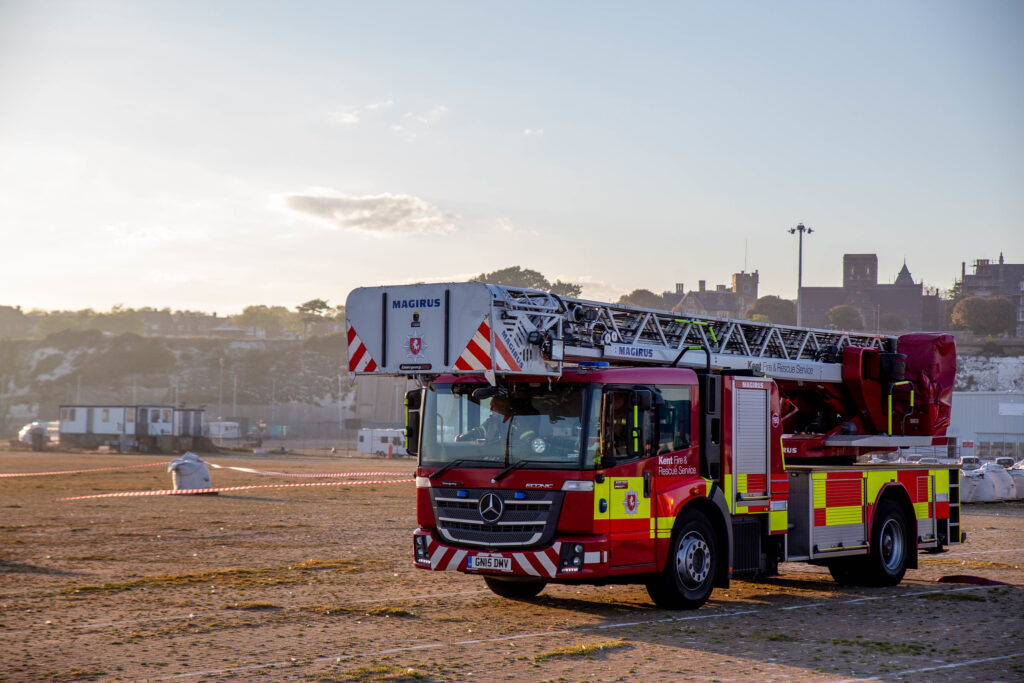Kent Fire and Rescue, as one of the larger fire authorities in the country, is taking on the responsibility of bringing together services from around the country. In his relatively new role as Head of Procurement, Gavin Wolstenhulme wants to join forces to achieve greater value when it comes to securing critical contracts. Chief Executive, Ann Millington has long championed this idea, and is happy to see steps in the right direction despite imminent regulatory changes on the horizon too.
Kent Fire and Rescue is presumably quite self-explanatory as a title, to explain what you do. But Gavin, perhaps you could introduce us to your specific remit, and especially to the procurement side of the organisation…
I’m Head of Procurement at Kent Fire and Rescue service, but the formal name is Kent and Medway Towns Fire Authority – we are a fire authority.
We rescue people in lots of different situations they find themselves in. We work closely with partners across blue light – fire, police, ambulance and coast guard – and other public services too.
My role specifically relates to everything that we as an Authority source, buy and procure. It involves management of the contracts we have, to ensure everything is where and how we need it to be in critical situations across Kent.
I have a team of 13 and in the office we’re very much category management-led. So, we have Category Managers who specialise in certain areas. And then our customers are those internal customers – firefighters, station managers, corporate services, etc.
We ensure that we compliantly buy everything that the fire service needs.
Click Below: view the digital brochure version of this content
Could you go into more detail around the category management areas? To a layperson on the outside, the needs of a fire service seem quite obvious but I’m sure there are far more nuances than that?
Yes, so we have professional services too, to account for the vast amounts of training that has to take place. This also envelopes HR and consultancy and the like.
You’ve then got fleet, which does indeed speak for itself. However, it is important to confirm you can’t just buy a fire engine off the shelf. We’re talking very specialist equipment in that area.
That goes for operational equipment as another category, too. This is your hoses, your ladders, your PPE.
Then there’s facilities management too, managing the buildings and stations that house our people, fleet and equipment.
There are subcategories to these too, and I’m blessed with a very good team behind me who are very skilled and know exactly what they need to do, which makes my life a little bit easier. I can trust them to go on and do the job that they’re employed to do.
Within the team, we also have people who work with more a national mindset too, working collaboratively with other fire services.
Is that commonplace, to collaborate with other fire services?
Maybe not as much as we’d like, which I’ll certainly come to. But there are good examples, such as with PPE. MSA, who provide our structural fire kits, came about as a partnership as a result of us driving national collaboration and creating a framework for that specialist fire PPE to be used. So, there are examples where a localised service can drive a good idea into the national structure, and to then manage the contracts that are formed off the back of that.

The collaboration becomes continuous at that point too. We enjoy regular meetings, reviews and strategy revisions with MSA, and I’m very much using it as a template for how I’d like all category managers to operate moving forward.
Every company and organisation seems to be undergoing a form of transformation at the moment. Is it the same with you, in the public space?
Yes, but maybe in a different way. Our transformation is very much compliancy-driven, and there’s a very significant reason for that. I joined in August ’23, but the work of both myself and my predecessor has been focused on the smooth transition to the new UK procurement regulations as a result of the new Procurement Act 2023, and the Procurement Regulations 2024 which come into effect this October.
We’re moving away from the EU procurement regulations, and it’s been my responsibility for the past year to ensure not only a smooth transition to remain compliant, but a successful one where I identify and realise value from the new framework.
My goal to this end hasn’t been to make sweeping changes, but to ensure my great team are also aware of the new regulations and remain compliant to them. And then, as a united team, we can see where efficiencies and value can be found.
How drastic are the regulation changes that you’re facing?
To be clear, it’s the biggest transformation in regulations and compliance in 25 years. Other organisations might be driven by tech ambitions and sustainability goals, and I want it to also be clear that they do form part of our objectives. But if we’re not compliant then all of those elements would fail to hit their mark.

So, my priority has been around partnership building. We work in a niche sector, and the best way to build an enabling environment where innovation can thrive and efficiencies can be made, all while being compliant, is to do so as a series of partnerships… an ecosystem. We have to build relationships, manage contracts effectively, and ensure there is mutual benefit for you and the supplier.
Presumably, this more collaborative culture means you’re more likely to unearth best value?
Exactly! We’re a public entity so are restricted by what we can spend, and this adds pressure to not ‘buy cheap and buy twice’, but to ensure the best quality every time. And by ‘quality’ what I really mean is ‘value’.
Value for money is critical in any public sector contract – it has to be managed in such a way that both the supplier and us as an authority get the best out of that contract. And you can only do that by working together as a partnership and managing those contracts correctly. If you don’t have that, authorities don’t have the time or the capacity to constantly rectify and double check or revise contracts that were wrong to begin with.
What are the main elements of the new regulations that are presenting either challenges or opportunities?
I suppose the new regulations are there to add flexibility, to aid the contract management side of things, and to encourage transparency with spending. The challenge is that it does put more onus on procurement to publish more notices, and more contracts over a certain value. So, you also need to go in and redact things and make sure that these published notices aren’t giving any commercial sensitivities away. So, it’s transparency with an extra dose of workload. But the payoff is greater flexibility in the contracts you’re able to generate.
With this new way of working, it puts extra emphasis on the need to get the requirements right first time. This means working with suppliers to design a specification that is correct straight off the bat, rather buying what we think we want, and suppliers then taking it upon themselves to be more creative or innovative and adapt that initial request.
The new regulations allow for that flexibility to talk to suppliers in pre-market engagement and get the whole process off to the best possible start.
Content Sponsor: MSA
When you talk about ‘collaboration’ I’m sensing that this still feels quite novel as a general concept in the sector?
Well, let’s put it this way, there are 44 fire authorities and services, and essentially we’re all buying the same things – fire engines, equipment, PPE, etc. And yet, for the most part, different services do this in different ways, and you wouldn’t believe some of the conflicts or arguments that arise.
The colour of a uniform, the wording on the back of the uniform, how it’s embroidered, the emblems, etc. I’m not underplaying those elements as they are sources of pride and identity, but they do work against the notion of collaboration which would really help when it comes to contracts and procurement more generally.
Greater economies of scale give you more flexibility to go out and find the absolute best solution in the market.
Ann, if I can come to you at this point. I understand you joined as HR Director back in 2007, and have occupied a variety of roles since then, culminating in the Chief Executive position since 2011. How critical from your perspective, is this coming together of national fire authorities?
So, in my current role, I’ve helped introduce the People Programme and the National Commercial Programme. The latter was very much formed with the intention of joining the fire services together when it comes to procurement.
It really is the holy grail.
From your vantage point, how have you seen the procurement function change over your tenure?
The function is far bigger now. Before, it was much smaller, but it was also like the wild west. You had people with good intent, having conversations with suppliers and choosing something because it felt and looked right. There was no great analysis and project management as a concept was quite nascent.
The intent was good, but there wasn’t a whole lot of attention being paid to actual value.
So, with the two Heads of Procurement I’ve worked with before Gavin, and now Gavin himself, I’ve tasked them with making the project management side of things more mature and meticulous.
What are we trying to do? What are the specifications of the contract? What issues might there be?
These are questions that have become part of a much more mature procurement function under the great guidance of those three people.
And then greater collaboration can help to take that default culture to the next level?
Yes, precisely. There are already lots of good threads and genuine collaboration as Gavin has explained with MSA for example.

We see the odd projects coming to fruition through great collaboration among some services, and also the rest of the blue light ecosystem too, but we are still driving to get energy behind that becoming a standard way of operating.
Ann, what would you say are the implications of a lack of analysis and collaborative input?
Well, it would be like needing to buy a car and literally going for the first one you come across. That’s without thinking about what you both like and need. Diesel, or petrol or electric? Colour? Power? Mileage?
Is anyone seriously saying they didn’t attempt to look into those elements before deciding? Of course not, so it shouldn’t be the case here. Yes, it might mean a slower process, but if you end up buying right, first time, then it’s worth it in the end. And then, once that patience is there and the mindset is there, having more flexible regulations, a team that knows what it’s doing, and greater economies of scale alongside other authorities, all ensures you get the best value from the best product or service.
Gavin, if I can come back to you… Are there examples where you’ve seen positive collaboration come to fruition, even in your short tenure so far?
Oh yes, certainly. Here in Kent, I can immediately think of three. One was where we worked with three other fire services for our control and command system. Another revolved around our breathing apparatus. And we’re national leads on the national framework for structural fire PPE as mentioned already.
We’re all working towards the same ultimate goal, which is to help people, and we can best do that with contracts that have come about from a greater economy of scale and national collaboration.
It sounds as if you’re trying to establish a change in culture. And presumably, that has also been the case internally, with the development of your team?
Absolutely – we’ve undertaken the Government-backed certified training for the new procurement regulations, and really that’s for their own development as much as anything else.
We need them to be compliant here, but these are national regulations, and having the training on their CV will be something that helps them long into the future and into their careers.
We want to keep them as long as possible of course, though, and we now have such a great team who can speak confidently with customers and with partners and suppliers, knowing exactly what’s allowable and doable from a regulatory perspective.
I’m all for development and in my one year here I’ve already promoted people within my team from Officer to Manager, recognising the hard work they’ve put in to better themselves and to help the Authority.

When you think of successes and milestones over the course of your first year in the role, is that training of the team right up there?
Definitely. Having them all trained and certified in the new regulations was imperative, but also so beneficial for us in finding value and forming partnerships.
Inevitably, there has also been some staff churn during this period too, so I must also commend the recruitment process, to juggle alongside the training and development of remaining staff.
Then there’s the project side of things and moving closer to awarding contracts. For procurement, it might just sound like our day-to-day imperative, but we’re talking big projects amounting to 10s of millions of pounds. So, to identify value, form partnerships, move forward in the right way, and then award those contracts is definitely a point of success to mention.
Ann, how about you? What has stood out for you over the past year?
What people love about Gavin is that he’s very solution-oriented and very pragmatic. We have new legislation coming our way and he’s firstly made sure that everyone understands it. He’s not dived in with new ways of working – he’s initially ensured everyone is up to speed with what compliancy looks like moving forward.
This generates a quick sense of trust, but also means that any problems are solved much more quickly when everyone can see immediately what is going wrong. There’s consistency in our messaging and communication because everyone knows the regulations.
Then I’ve also been impressed by the balance between preparedness and risk. Procurement isn’t risk averse. You can spend the entire time thinking ‘I can’t do that, or I shouldn’t try that’ and you could end up doing nothing. That is just tiresome.
Gavin has immediately picked up from where his predecessor left off, to get everyone reading from the same page and then achieving that balance of proactivity and preparedness.
Moving forward, Gavin, I’m sensing a major goal for you is to enhance that level of national collaboration as we’ve already discussed?
We don’t live in siloes as things stand – we do talk to each other and there are opportunities to explore. However, it does then tend to be a few larger authorities who have to lead on ultimate projects. Some of the smaller ones simply don’t have the capacity we do or the team size we have.
And that’s why, for a long time now, my overarching aim is to get all 44 heads of procurement in one room and have a chat about what can be done and how we could buy better as a more collaborative and holistic group. I realised quite quickly that wasn’t possible at the time, but the goal remains.
I can’t emphasise enough how important this collaboration is. We can be more standardised, put silly arguments around shirt colours and emblems aside, stop wasting time and money, and instead create much greater economies of scale to seek out the absolute best suppliers and proposition for the whole country.
The new regulations actually give us more flexibility in this regard, so as long as we remain compliant with those, the only thing left holding us back is our own separation or lack of unity. With the new framework, we can strive for eight or even 10-year contracts which is far longer than what we’ve had until now, so there really is the opportunity to set our stall out, find the best value, and then secure that value for years and years after.
Here, that value means access to innovation, seamless supply of critical solutions and products, better sustainability, and all at a much lower – overall – cost.
Ann, how would you like to sign off?
I think it’s just to remind that we are managing, essentially, by public consent. This goes beyond just being compliant and being there with hoses when someone needs us. It means spending money wisely, and sometimes creatively. For example, we’re excited about the introduction of a new robot that will remove firefighters from some dangerous situations, new kit, new equipment, better ways of managing wildfires.
Procurement is at the centre of these more general fire authority drives and improvements. We have to find solutions that are fit for purpose, but also feasible.
It’s why Gavin’s team has got so much bigger, as we make sure we have every base covered.
We’re also answerable to the firefighters, though. An emblem or colour may sound trivial but research has shown their three main concerns are what the station looks like (as their second home), their PPE and their kit. It’s not just safety. It’s also pride in their work, and we can’t just ignore that.
The good thing about the kind of procurement function that we’re striving for is that it enables change, no matter how big or small those changes are. It’s not a mute partner, but a pivotal strand of broader project management. Ultimately, it’s a fundamental part of how we as an organisation, and – hopefully, more and more – as a united national entity, operates.



